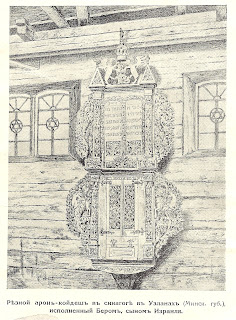The book was the first real inventory and study of these synagogues. Where photographs of the synagogues did not exist, the authors reconstructed them in drawings from descriptions and records. Such is the case of the Uzlyany structure. We only have drawings and reconstructions, but at least those sources help to provide a witness to its existence.
Using the notes and drawings of the Piechotka's, a David Dawidowicz made models of many of the synagogues, including the one in Uzlyany, below. Link to Wooden Synagogues of Poland web site
Years ago, I found a postcard with a rendering of a Holy Ark. I later learned that this postcard is of the Holy Ark from the Uzlyany synagogue.
While the outside of the synagogue seems plain, the inside was glorious, as the intricate work on the Ark attests. From the research I have done, most of the wooden synagogues were full of beautiful woodwork, and often had vividly painted walls with symbols and colorful designs.
David Fox told his son Marvin that the depiction of the shtetl in the movie Fiddler on the Roof was very close to the Uzlyany he remembered. The synagogue in Fiddler was a wooden one, much like Uzlyany's, simple on the outside but beautiful within. The movie is well worth watching for the sets alone, which can provide us with a visual grasp of our ancestors' lives.




